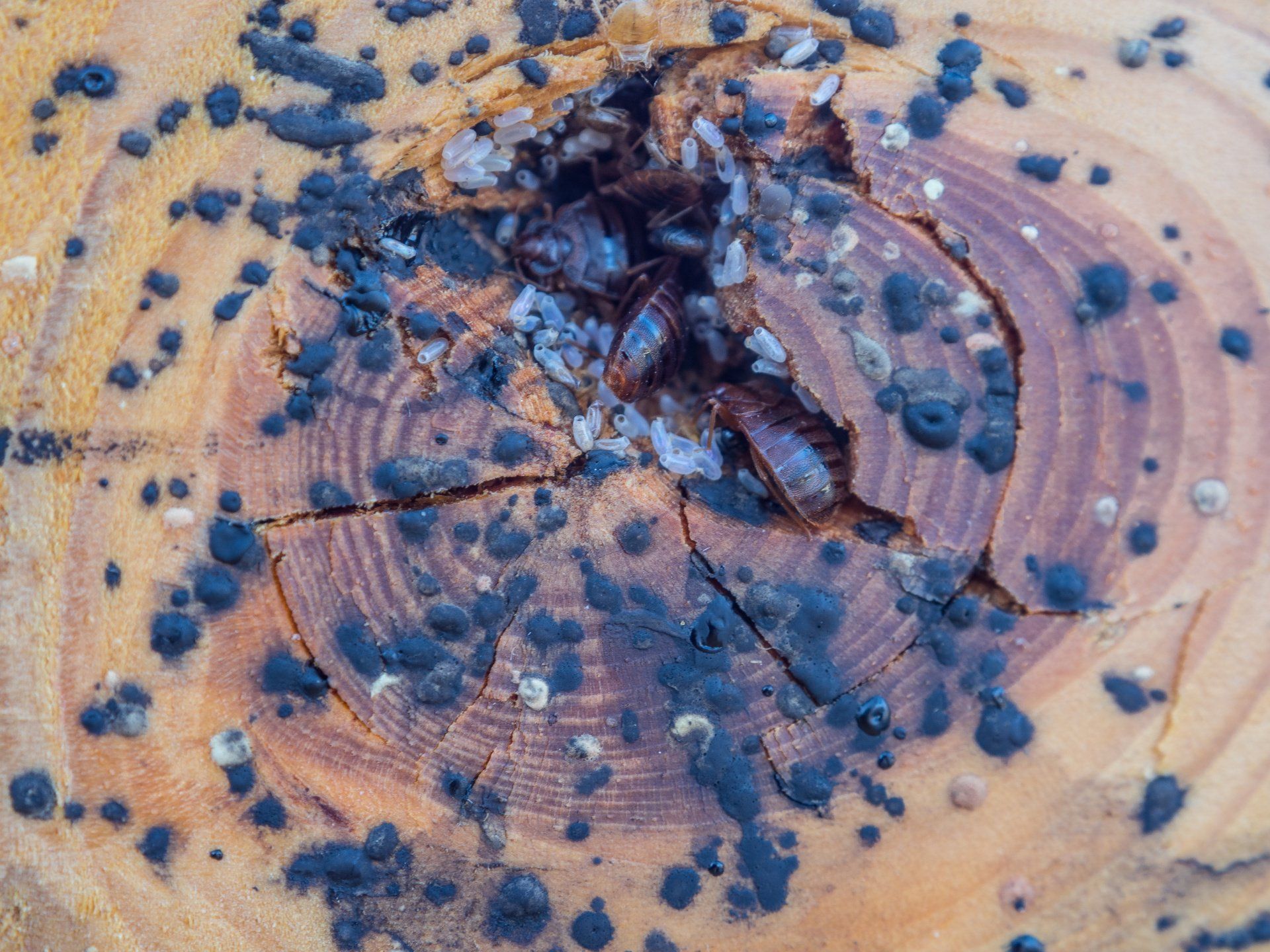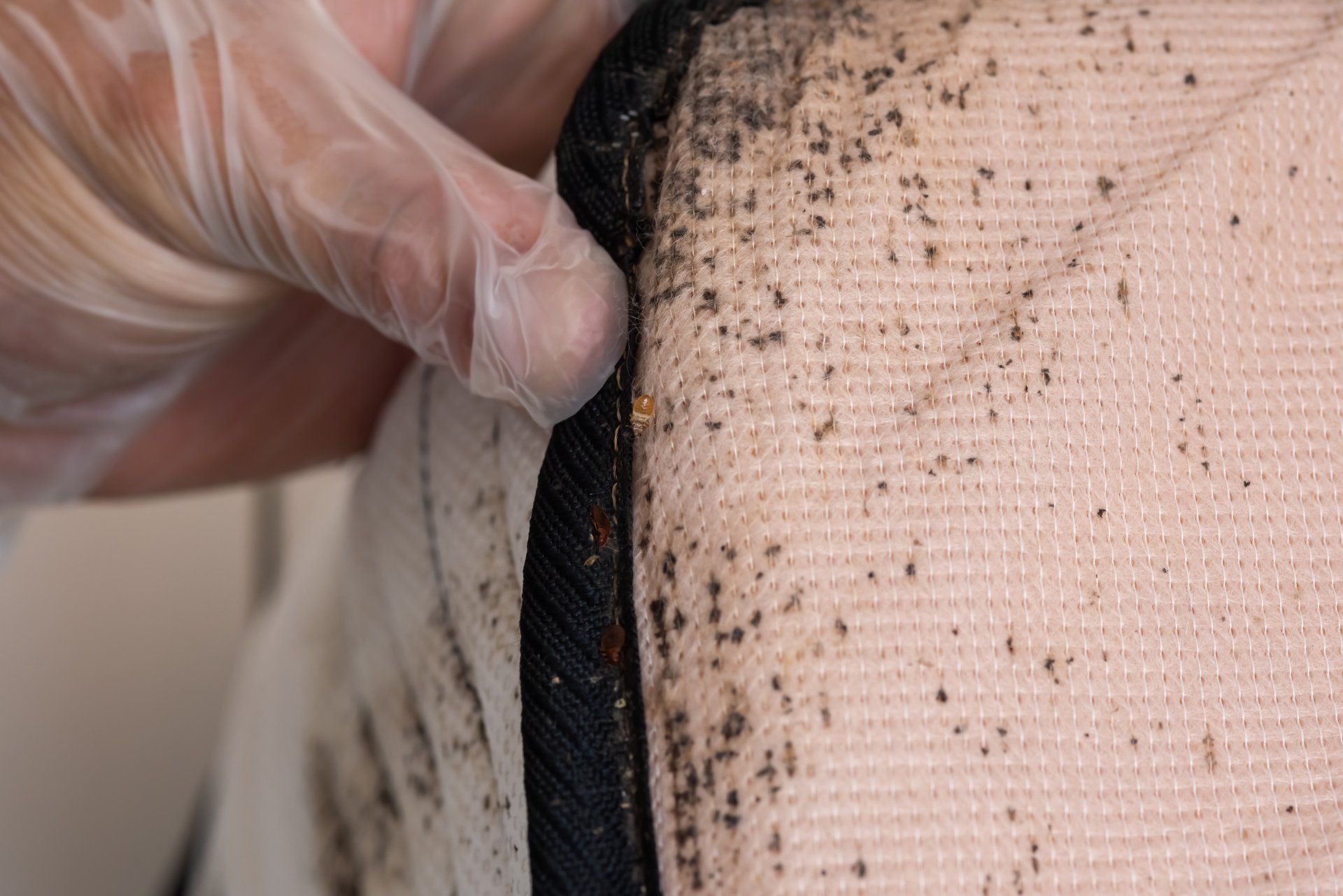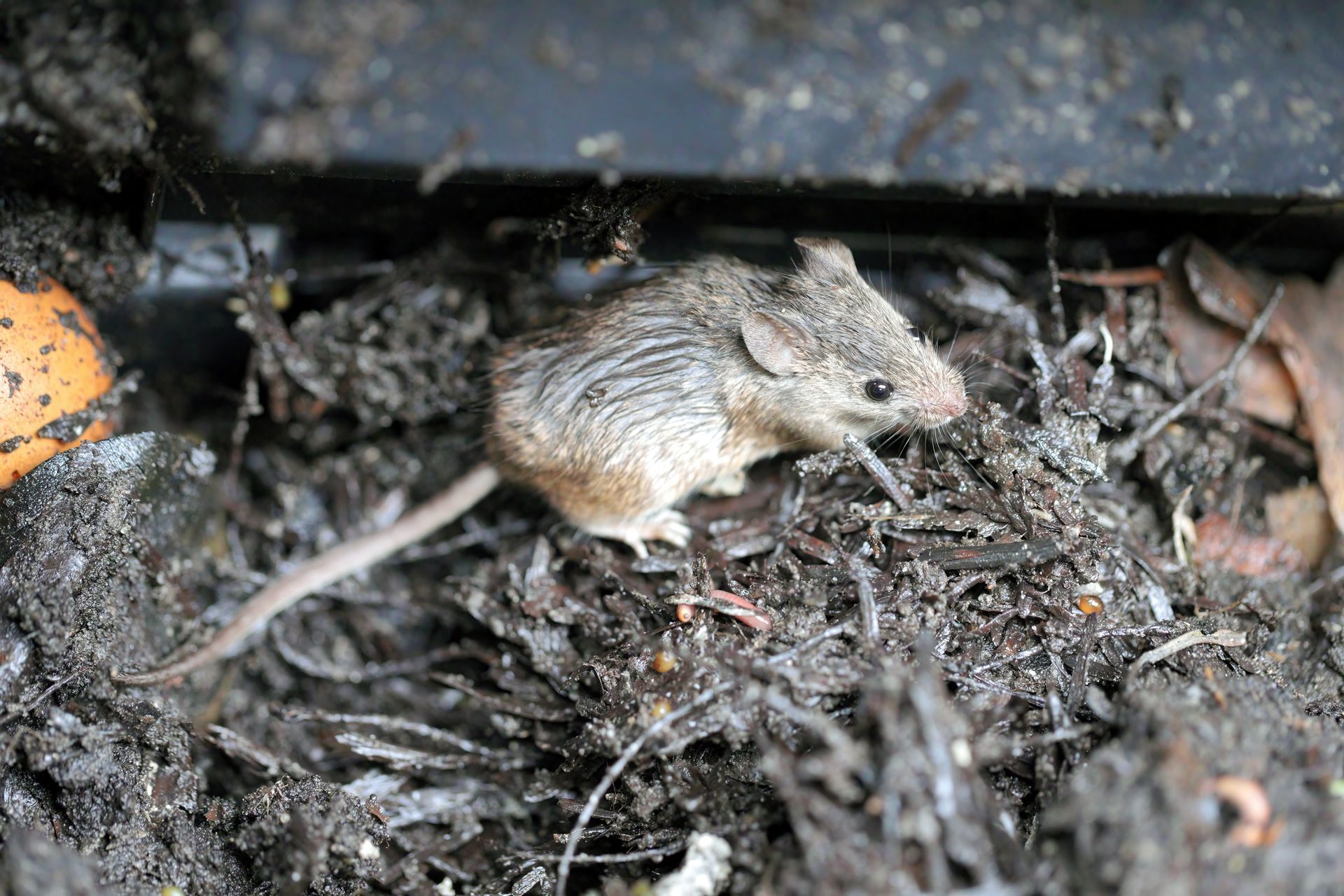Bed Bug Droppings
What Does Bed Bug Poop Look Like?

Bed bugs are bloodsucking pests that are notorious for being extremely persistent and causing itchy red bites. If you have ever dealt with them before, you know how traumatizing it is to be fed on constantly while you sleep. If you were not aware that you have a bed bug problem but have noticed bites appearing on your body when you wake up, it is a sign that you may be dealing with the start of a bed bug infestation. Another common sign that indicates bed bugs is seeing bed bug droppings on or around your mattress. Since bed bugs feed on blood, they excrete a byproduct of their blood meal which looks like tiny, dark, ink like splotches that can be found in the seams of your mattress and wherever else bed bugs can be found.
How to Identify Bed Bug Feces
Since bed bugs only feed on blood, their poop has a consistent color, size, and shape. The color of bed bug poop is generally a very dark rusty brown color that almost appears black in some instances. Since bed bug waste is a byproduct of blood, the consistency tends to be more liquid than solid. This means that it acts similarly to if you were to put a ballpoint pen against a piece of paper and allowed the ink to bleed out from the point where the pen is in contact with the piece of paper. The size of bed bug droppings is usually very small, but as they bleed into fabrics over time, the size of the bed bug poop stain will grow slightly. The shape of bed bug waste starts out as a small pinpoint, but similar to size, will grow outward as it stains and smears into whatever material the waste is on.
Will Bed Bug Feces Smear?
Bed bug poop will tend to smear so a good way to tell if a small stain is bed bug poop is to check for bed bug poop using a damp Q tip. If the stain smears into a reddish-brown streak when the Q tip is wiped over the stain, then there is a good chance you are looking at bed bug poop. Also check the Q tip to see if the tip has turned a dark brown from the stain.
Where to Find Bed Bug Poop
Bed bug poop is generally found wherever clusters of bed bugs exist. Since bed bugs prefer to stay within a short distance of their host, most bed bug infestations start on the mattress. Bed bugs prefer to stay hidden during the day, so they won’t be found just anywhere on a mattress. Be sure to check the seams of the mattress, under the mattress label, in the seams of the box spring, and in between or near any joints in the box spring or bed frame for signs of bed bugs. If a bed bug infestation has gotten out of hand and there are too many bed bugs in one area, they will move on in search of other food sources. This will lead bed bugs to explore carpets, base boards, nightstands, dressers, electrical outlets, and pretty much any other wooden or fabric materials inside of an infested room. When this happens, seeing bed bug poop stains are a good indicator of problematic areas that may need treatment. In addition to seeing bed bug poop stains, seeing molted bed bug skins is another indicator that bed bugs have started to move through the stages of the bed bug life cycle which indicates a much larger problem.
What Does Bed Bug Poop Look Like on Sheets and Bedding?
Finding bed bug poop on sheets and bedding is rare because after bed bugs feed, they are vulnerable and prefer to retreat to their preferred place of hiding. This allows them to digest their blood meal as well as lay their next round of eggs which happens every time they feed. If there are stains found on sheets and bedding, it is likely the result of recent bed bug bites that shed a drop of blood or a freshly fed bed bug that may have been smashed on accident from their host turning over in their sleep. Both of these instances would appear much more like a normal blood stain which would not be a bed bug poop stain. That being said, this is still an indicator that you have a bed bug problem that needs to be addressed.
Bed Bug Droppings on the Mattress

Bed bug poop is more likely to be found on mattresses and box springs rather than being found on bedding or sheets. This is because bed bugs excrete waste where they tend to hide. Most of the time bed bugs will hide under the seams of the mattress or in the joints of the box spring where they gather in small clusters, poop, and lay eggs. Individuals can look under the mattress seams to see if there are groups of what looks like small ink stains. If there are, then you have most likely found a bed bug harborage area that needs to be treated.
Does Bed Bug Poop Smell?
Bed bug poop doesn’t smell rancid like the waste of animals, and this is because it is primarily digested blood. Instead, bed bug poop tends to have a slightly sweet, musty to rusty smell that is the result of pheromones found in bed bug poop as well as oxidation that occurs to the iron in the blood. That sweet, musty smell is due to an aggregation pheromone that is used to mark safe hiding places which bed bugs return to after feeding.
Why You Should Clean Up Bed Bug Droppings
Cleaning up bed bug waste is critical to controlling bed bug populations. As mentioned above, bed bug feces contain an aggregation pheromone that draws bed bugs back to their hiding spots. As an infestation develops, newly hatched bed bug nymphs will search out food and return to the site they hatched from because of the pheromones left by older generations of bed bugs. This will cause bed bug clusters to expand around a central hiding place until populations grow so large that bed bugs are forced to search for new places to hide. Even if an area is treated, if there are any remaining bed bugs left, they will be able to use those pheromones to find safe harborage points and a close by host.
Does Bed Bug Poop Cause Health Problems?
While bed bug poop typically does not cause major health problems, there are studies that indicate that the presence of bed bug poop can trigger allergies. This is because some compounds found within bed bug waste contain histamines which trigger allergic responses. Researchers have shown that homes with bed bug infestations had at least 20x the amount of histamines that a home without a bed bug infestation would have. In these studies, the amount of histamines remained even after bed bugs were treated effectively. This indicates that the bed bug waste was the allergy trigger and that it would continue to cause problems after bed bugs were exterminated unless thorough cleaning of bed bug waste occurred.
How to Clean Up Bed Bug Feces
Since bed bug fecal matter is in a semi liquid state similar to that of toothpaste, it tends to bleed into its surrounding material or smear. If the bed bug poop has already been absorbed into the surrounding mattress fabric or material, the stain will most likely be difficult to remove as blood tends to stain permanently without specialized cleaning. If it has been absorbed, there are specific enzyme-based cleaning solutions designed to break down difficult to remove stains. These cleaning solutions will need be applied and left on for a while to help lift the bed bug poop stain from the material. After cleaning, any remaining discoloration should be treated with a cold water and hydrogen peroxide mix to help return the material back to its original color. Hydrogen peroxide acts as an oxidizer and stain remover so it should only be left on for about 10 minutes otherwise there is the risk of damaging the mattress material.
Can Bed Bug Droppings Be Picked Up?
Bed bug droppings can’t be picked up like the waste of other animals because it has a semi liquid consistency. This results in the waste being too soft to pick up without accidentally smearing it onto whatever surface it lays on. Given enough time, the waste will eventually bleed into porous or absorbent materials like mattresses and wood causing stains. Sometimes when bed bug droppings are laid on nonabsorbent materials, they can eventually dry out into a solid. When this happens, the poop is still too small to pick up individually and would most likely need to vacuumed in order to collect it.
What Should You Do After You Clean Up Bed Bug Droppings?
After treating bed bugs and cleaning up signs of bed bug droppings, it is recommended that the mattress and box spring are steamed using high temperatures to kill off any remaining bed bugs. Then the mattress and box spring should be completely covered in a bed bug proof encasements. These covers are designed to trap any remaining bed bugs in to prevent further bites. In addition to using encasements, be sure to use bed bug monitors placed at the footing of the bedframe to catch any bed bugs that attempt to crawl up from the carpet. These traps create a space that bed bugs have to traverse before they are able to reach the bed frame footings. As they try to reach the footings, they will fall into a small valley with smooth plastic surfaces that are designed to prevent the bed bugs from crawling out. In the event that treatments have failed, and the monitors indicate there are remaining bed bugs, it is likely time to enlist professional help to treat for bed bugs.
Contact EcoGuard Pest Management for Bed Bug Treatment Options
When all other bed bug mitigation attempts fail, the last step would be to hire professionals who have the training and experience to effectively treat a bed bug infestation. Our team of licensed bed bug control experts at EcoGuard Pest Management know exactly what to look for and where to look when inspecting for problematic areas that show signs of bed bug activity. Call today to schedule an inspection so our bed bug exterminators can create a customized plan to effectively get rid of bed bugs inside your home.

















